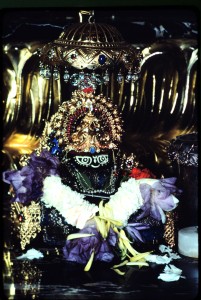Salagram-Sila appears at New Vrindaban
Salagram-Sila appears at New Vrindaban
by Henry Doktorski (Hrishikesh dasa)
During May 1977, the first Salagram-Sila appeared at New Vrindaban. Salagram-Sila is a Vaisnava murti in the form of a spherical, usually black-colored stone found in the sacred river Gandaki, a tributary of the Ganges and one of the major rivers of Nepal and India. Geologists believe the river is older than the Himalayas; as tectonic activity forced the mountains higher, the river has cut through the uplift to maintain its course.
Salagram-Sila stones are naturally formed, with circular or spiral markings and are found in particular kinds of ocean sediments, which have been uplifted to the top of the Himalayas. The word Sila translates simply to “stone” and Salagram is a name of Visnu. The origin of the name is traced to a remote village in Nepal where Visnu is known by the name of Salagraman.
The Silas are worshipped as manifestations of Visnu Himself, identifiable from other stones by special markings believed to resemble Visnu’s paraphernalia such as mace, conch, lotus and disc. Nrsimhadeva, Varahadeva and Vamanadeva are popular forms of worship. They are either black, red, or mixed in color and are usually kept closed in a box and are only brought out for daily worship (puja). Traditionally Silas are acquired by heredity and are passed down through many generations, never being purchased or sold.
According to Vaisnava belief, the worshipper of a Salagram-Sila must adhere to strict rules, such as not touching the Salagram without bathing, never placing the Salagram on the ground, eating only prasadam, and not indulging in bad practices.
The [June 1977 issue of the] Brijabasi Spirit reported about the acquisition of the silas for New Vrindaban:
More than a year ago, we read in Caitanya-Caritamrita that Srila Prabhupada desired to introduce Salagram-Sila worship in the West. He said at the time this worship of Salagram was not going on, but that soon it would be established as a regular function of every ISKCON temple. Last month in New Vrindaban, Prabhupada’s desire became manifest as Salagram-Sila appeared on the altar of Sri Sri Radha-Vrindaban Candra.
All the members of the community were very much excited about the Lord’s arrival. When He appeared on the altar for the first time, His smiling face bestowing benedictions upon all His devotees, everyone’s expectations were more than satisfied. The Lord’s beauty is without comparison to anything in the material world. Simply by seeing His transcendental form one loses all desire to see anything else. As stated in the second chapter of Bhagavad-Gita, param drstva nirvartate: by experiencing a higher taste one gives up his attraction for sense objects. . . .
Kirtanananda Maharaja placed Kuladri dasa in charge of serving Salagram, and this has turned out to be a full-time engagement for Kuladri. . . . We have two Salagrams residing on Radha-Vrindaban Candra’s altar, each seated on His own throne. Their characteristics have been identified as being those of Sri Hiranyagarbha and Sri Sudarsana. Unlike the Deity form, in which Krishna enters upon the request of the Acarya, Salagram-Sila is and always was Krishna, with or without installation.
There is a special river high in the Himalayas from which Salagrams appear. One must enter the water and after chanting special mantras one calls loudly the name of the particular Salagram-Sila he desires to worship. Each Salagram-Sila has distinct characteristics identifiable by brahmanas expert in the science. This is the method of acquisition as related to us by one of our senior godbrothers presently residing in India.
The author was a resident of New Vrindaban from 1978 until 1994.



